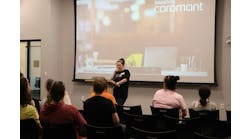The VGo robotic telepresense device enables users to interact remotely with others no matter where they are.
The Vecna QCBot can deliver products or materials in any dynamic environment.
Vecna Technologies, Inc., a provider of robotic logistics and IT healthcare solutions, has acquired VGo Communications, Inc., a maker of robotic telepresence solutions.“Vecna and VGo’s missions are highly aligned. We believe robots can enhance the quality of life for people everywhere,” said Daniel Theobald, Vecna’s co-founder and CTO. “Customers from both companies will benefit from adding VGo to Vecna’s portfolio of solutions with applications in healthcare, hospitality, manufacturing, distribution and education.”
The place these product lines -- with their largest presence in logistics and healthcare -- have in more traditional manufacturing environments may seem obscure at first, but a closer look at them reveals a number of intersection points. Vecna’s autonomous mobile robots are built to operate in human-centric environments. Equipped with multiple sensors, they can operate in dynamic environments and respond appropriately when confronted with obstacles, such as a person walking down a corridor in front of them. They can also carry up to 3,200 pounds of load at speeds up to 3 m/s.
Vecna robots are used in hospitals to deliver linens, supplies and equipment without human intervention. This same capability makes them useful in warehousing environments and for delivering parts, materials and equipment in manufacturing environments. Vecna palletizing robots have applications in warehouse and logistics operations.
Theobald says that the same uses apply in a manufacturing environments. “Robots are very agile and flexible,” he says. “By automating material transport between your stock room, assembly, test and packaging, you can rapidly reconfigure your production line without the expense of changing track systems, conveyor belts and other fixed assets.”
The addition of the VGo line adds another dimension of functionality to the Vecna line, says Theobald. “If we can include VGo in our package, we can effectively supply support for it. At Audi, they use them to support their mechanics.”
One VGo customer, Reimer’s Electra Steam, a manufacturer of steam boilers and generators, uses a VGo so that one of its engineers, who works remotely from overseas, can interact with his peers on the production floor.
Theobald suggests that the same logic could allow an expert, either retired or still on the payroll, to provide remote support and/or training.
The VGo solution looks like a small video monitor on a pole, but this pole is battery-powered and moves about on its own. It also has sensors that detect obstacles and allow the robot to move safely in an environment where humans also are moving around. Using proprietary software installed on their tablet or computer, remote users connect to the VGo and are automatically “present” in a conference, on a factory floor or wherever the real-time interaction is taking place.
Theobald admits that letting robots roam freely around a manufacturing floor may take some getting used to, especially in environments where workers are used to seeing them caged off from humans for safety reasons. He says Vecna’s approach to overcoming these concerns is to emphasize safety.
“Vecna from beginning has said that safety is top priority. We provide economic value safely. Letting robots out of their cage is new. People are going to have to get used to that idea. It’s probably going to take time.” But he adds: “A lot of organizations are using this. People are getting more and more comfortable with it. Selling it from a safety perspective is going to be the approach."




